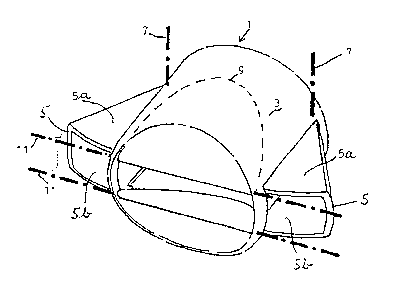Une partie des informations de ce site Web a été fournie par des sources externes. Le gouvernement du Canada n'assume aucune responsabilité concernant la précision, l'actualité ou la fiabilité des informations fournies par les sources externes. Les utilisateurs qui désirent employer cette information devraient consulter directement la source des informations. Le contenu fourni par les sources externes n'est pas assujetti aux exigences sur les langues officielles, la protection des renseignements personnels et l'accessibilité.
L'apparition de différences dans le texte et l'image des Revendications et de l'Abrégé dépend du moment auquel le document est publié. Les textes des Revendications et de l'Abrégé sont affichés :
| (12) Demande de brevet: | (11) CA 2352119 |
|---|---|
| (54) Titre français: | EMBOUT DE SECHE-CHEVEUX A CONFIGURATION VARIABLE |
| (54) Titre anglais: | HAIRDRYER NOZZLE WITH VARIABLE CONFIGURATION |
| Statut: | Réputée abandonnée et au-delà du délai pour le rétablissement - en attente de la réponse à l’avis de communication rejetée |
| (51) Classification internationale des brevets (CIB): |
|
|---|---|
| (72) Inventeurs : |
|
| (73) Titulaires : |
|
| (71) Demandeurs : |
|
| (74) Agent: | GOWLING WLG (CANADA) LLP |
| (74) Co-agent: | |
| (45) Délivré: | |
| (86) Date de dépôt PCT: | 1999-12-07 |
| (87) Mise à la disponibilité du public: | 2000-06-15 |
| Licence disponible: | S.O. |
| Cédé au domaine public: | S.O. |
| (25) Langue des documents déposés: | Anglais |
| Traité de coopération en matière de brevets (PCT): | Oui |
|---|---|
| (86) Numéro de la demande PCT: | PCT/BE1999/000160 |
| (87) Numéro de publication internationale PCT: | BE1999000160 |
| (85) Entrée nationale: | 2001-05-25 |
| (30) Données de priorité de la demande: | ||||||
|---|---|---|---|---|---|---|
|
Embout, amovible ou non, destiné à un sèche-cheveux, qui peut être modifié aisément depuis une première configuration fournissant un flux d'air chaud présentant une section sensiblement ronde, jusqu'à l'obtention d'un flux d'air à section sensiblement rectangulaire, c'est-à-dire large et plate. Cet embout est constitué par une virole (3), équipée de deux tiroirs (5) pouvant effectuer un mouvement de pivotement axial par rapport à des axes géométriques (7) et de volets (9) pouvant effectuer un mouvement de pivotement par rapport à des axes géométriques (11) perpendiculaires aux axes de pivotement (7) des tiroirs (5).
The invention concerns a nozzle, detachable or not, designed for a hairdryer,
which can be easily modified from a first configuration supplying a hot air
stream with a substantially circular cross-section to obtain an air stream
substantially rectangular, that is wide and flat, in cross-section. Said
nozzle consists of a ferrule (3) provided with two slots (5) capable of
pivoting relatively to geometrical axes (7) and flaps (9) capable of producing
a pivoting motion relatively to geometrical axes (11) perpendicular to the
pivot pins (7) of the slots (5).
Note : Les revendications sont présentées dans la langue officielle dans laquelle elles ont été soumises.
Note : Les descriptions sont présentées dans la langue officielle dans laquelle elles ont été soumises.

2024-08-01 : Dans le cadre de la transition vers les Brevets de nouvelle génération (BNG), la base de données sur les brevets canadiens (BDBC) contient désormais un Historique d'événement plus détaillé, qui reproduit le Journal des événements de notre nouvelle solution interne.
Veuillez noter que les événements débutant par « Inactive : » se réfèrent à des événements qui ne sont plus utilisés dans notre nouvelle solution interne.
Pour une meilleure compréhension de l'état de la demande ou brevet qui figure sur cette page, la rubrique Mise en garde , et les descriptions de Brevet , Historique d'événement , Taxes périodiques et Historique des paiements devraient être consultées.
| Description | Date |
|---|---|
| Inactive : IPRP reçu | 2008-01-10 |
| Demande non rétablie avant l'échéance | 2004-12-07 |
| Le délai pour l'annulation est expiré | 2004-12-07 |
| Réputée abandonnée - omission de répondre à un avis sur les taxes pour le maintien en état | 2003-12-08 |
| Inactive : Page couverture publiée | 2001-09-24 |
| Lettre envoyée | 2001-09-19 |
| Inactive : CIB en 1re position | 2001-08-26 |
| Inactive : Transfert individuel | 2001-08-14 |
| Inactive : Lettre de courtoisie - Preuve | 2001-08-07 |
| Inactive : Notice - Entrée phase nat. - Pas de RE | 2001-08-01 |
| Demande reçue - PCT | 2001-07-27 |
| Demande publiée (accessible au public) | 2000-06-15 |
| Date d'abandonnement | Raison | Date de rétablissement |
|---|---|---|
| 2003-12-08 |
Le dernier paiement a été reçu le 2002-12-06
Avis : Si le paiement en totalité n'a pas été reçu au plus tard à la date indiquée, une taxe supplémentaire peut être imposée, soit une des taxes suivantes :
Les taxes sur les brevets sont ajustées au 1er janvier de chaque année. Les montants ci-dessus sont les montants actuels s'ils sont reçus au plus tard le 31 décembre de l'année en cours.
Veuillez vous référer à la page web des
taxes sur les brevets
de l'OPIC pour voir tous les montants actuels des taxes.
| Type de taxes | Anniversaire | Échéance | Date payée |
|---|---|---|---|
| Taxe nationale de base - générale | 2001-05-25 | ||
| Enregistrement d'un document | 2001-08-14 | ||
| TM (demande, 2e anniv.) - générale | 02 | 2001-12-07 | 2001-10-04 |
| TM (demande, 3e anniv.) - générale | 03 | 2002-12-09 | 2002-12-06 |
Les titulaires actuels et antérieures au dossier sont affichés en ordre alphabétique.
| Titulaires actuels au dossier |
|---|
| FACO S.A. |
| Titulaires antérieures au dossier |
|---|
| HENRI SMAL |